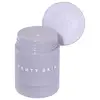What's inside
What's inside
 Key Ingredients
Key Ingredients

 Benefits
Benefits

 Concerns
Concerns

 Ingredients Side-by-side
Ingredients Side-by-side

Water
Skin ConditioningGlycerin
HumectantCarrageenan
Cocos Nucifera Fruit Extract
EmollientPinus Sylvestris Leaf Extract
TonicRetinol
Skin ConditioningHydrogenated Lecithin
EmulsifyingTocopheryl Acetate
AntioxidantOctapeptide-7
Skin ProtectingSh-Decapeptide-7
AntioxidantSh-Octapeptide-4
AntioxidantSh-Oligopeptide-9
HumectantSh-Pentapeptide-19
Skin ConditioningAloe Barbadensis Leaf Extract
EmollientRicinus Communis Seed Oil
MaskingAdenosine
Skin ConditioningAllantoin
Skin ConditioningCaffeine
Skin ConditioningPropanediol
SolventPolyglyceryl-10 Laurate
Skin ConditioningCeratonia Siliqua Gum
EmollientSucrose
HumectantCalcium Lactate
AstringentCalcium Chloride
AstringentCellulose Gum
Emulsion StabilisingPotassium Chloride
Cyamopsis Tetragonoloba Gum
Emulsion StabilisingArginine
MaskingHydrolyzed Extensin
Skin ConditioningDipotassium Glycyrrhizate
HumectantSynthetic Fluorphlogopite
Maltodextrin
AbsorbentSodium Hyaluronate
HumectantEthylhexylglycerin
Skin ConditioningTitanium Dioxide
Cosmetic ColorantChromium Oxide Greens
Polysorbate 20
EmulsifyingButylene Glycol
HumectantPentylene Glycol
Skin ConditioningEthyl Hexanediol
Solvent1,2-Hexanediol
Skin ConditioningChlorphenesin
AntimicrobialDisodium EDTA
Water, Glycerin, Carrageenan, Cocos Nucifera Fruit Extract, Pinus Sylvestris Leaf Extract, Retinol, Hydrogenated Lecithin, Tocopheryl Acetate, Octapeptide-7, Sh-Decapeptide-7, Sh-Octapeptide-4, Sh-Oligopeptide-9, Sh-Pentapeptide-19, Aloe Barbadensis Leaf Extract, Ricinus Communis Seed Oil, Adenosine, Allantoin, Caffeine, Propanediol, Polyglyceryl-10 Laurate, Ceratonia Siliqua Gum, Sucrose, Calcium Lactate, Calcium Chloride, Cellulose Gum, Potassium Chloride, Cyamopsis Tetragonoloba Gum, Arginine, Hydrolyzed Extensin, Dipotassium Glycyrrhizate, Synthetic Fluorphlogopite, Maltodextrin, Sodium Hyaluronate, Ethylhexylglycerin, Titanium Dioxide, Chromium Oxide Greens, Polysorbate 20, Butylene Glycol, Pentylene Glycol, Ethyl Hexanediol, 1,2-Hexanediol, Chlorphenesin, Disodium EDTA
Water
Skin ConditioningGlycerin
HumectantCaprylic/Capric Triglyceride
MaskingStearic Acid
CleansingPropanediol
SolventTrioctyldodecyl Citrate
EmollientNiacinamide
SmoothingSqualane
EmollientArachidyl Alcohol
EmollientCarthamus Tinctorius Oleosomes
EmollientShorea Stenoptera Seed Butter
EmollientDicaprylyl Carbonate
EmollientAcetyl Hexapeptide-8
HumectantCaffeine
Skin ConditioningHyaluronic Acid
HumectantSodium Hyaluronate
HumectantPolyglutamic Acid
Skin ConditioningTamarindus Indica Seed Polysaccharide
Skin ConditioningSodium PCA
HumectantManganese PCA
HumectantMagnesium PCA
HumectantZinc PCA
HumectantAdansonia Digitata Seed Oil
EmollientCitrullus Lanatus Seed Oil
EmollientAlbizia Julibrissin Bark Extract
MaskingMalpighia Glabra Fruit Juice
Skin ConditioningEscin
TonicPanthenol
Skin ConditioningTocopherol
AntioxidantGluconolactone
Skin ConditioningSynthetic Beeswax
Emulsion StabilisingMaltodextrin
AbsorbentGlucose
HumectantArachidyl Glucoside
EmulsifyingBehenyl Alcohol
EmollientGlyceryl Caprylate
EmollientLauroyl Lysine
Skin ConditioningSodium Polyacrylate
AbsorbentXanthan Gum
EmulsifyingMica
Cosmetic ColorantCaprylhydroxamic Acid
Tetrasodium Glutamate Diacetate
Sorbitan Isostearate
EmulsifyingSodium Benzoate
MaskingCaprylyl Glycol
EmollientPotassium Sorbate
PreservativeHydroxyethyl Acrylate/Sodium Acryloyldimethyl Taurate Copolymer
Emulsion StabilisingBis-Diglyceryl Polyacyladipate-2
EmollientDimethicone
EmollientCitric Acid
BufferingPhenoxyethanol
PreservativeCI 77891
Cosmetic ColorantCI 77491
Cosmetic ColorantWater, Glycerin, Caprylic/Capric Triglyceride, Stearic Acid, Propanediol, Trioctyldodecyl Citrate, Niacinamide, Squalane, Arachidyl Alcohol, Carthamus Tinctorius Oleosomes, Shorea Stenoptera Seed Butter, Dicaprylyl Carbonate, Acetyl Hexapeptide-8, Caffeine, Hyaluronic Acid, Sodium Hyaluronate, Polyglutamic Acid, Tamarindus Indica Seed Polysaccharide, Sodium PCA, Manganese PCA, Magnesium PCA, Zinc PCA, Adansonia Digitata Seed Oil, Citrullus Lanatus Seed Oil, Albizia Julibrissin Bark Extract, Malpighia Glabra Fruit Juice, Escin, Panthenol, Tocopherol, Gluconolactone, Synthetic Beeswax, Maltodextrin, Glucose, Arachidyl Glucoside, Behenyl Alcohol, Glyceryl Caprylate, Lauroyl Lysine, Sodium Polyacrylate, Xanthan Gum, Mica, Caprylhydroxamic Acid, Tetrasodium Glutamate Diacetate, Sorbitan Isostearate, Sodium Benzoate, Caprylyl Glycol, Potassium Sorbate, Hydroxyethyl Acrylate/Sodium Acryloyldimethyl Taurate Copolymer, Bis-Diglyceryl Polyacyladipate-2, Dimethicone, Citric Acid, Phenoxyethanol, CI 77891, CI 77491
 Reviews
Reviews

Ingredients Explained
These ingredients are found in both products.
Ingredients higher up in an ingredient list are typically present in a larger amount.
Caffeine is most associated with coffee, tea, and cacao. In skincare, it helps with calming inflammation and is rich in antioxidants.
While caffeine is used to treat cellulite and and dark circles, further studies are needed to prove this. It has been believed to help with these skin conditions due to its ability to dilate blood vessels and increase blood flow.
Some studies are looking into caffeine's ability to protect against UV rays.
Learn more about CaffeineGlycerin is already naturally found in your skin. It helps moisturize and protect your skin.
A study from 2016 found glycerin to be more effective as a humectant than AHAs and hyaluronic acid.
As a humectant, it helps the skin stay hydrated by pulling moisture to your skin. The low molecular weight of glycerin allows it to pull moisture into the deeper layers of your skin.
Hydrated skin improves your skin barrier; Your skin barrier helps protect against irritants and bacteria.
Glycerin has also been found to have antimicrobial and antiviral properties. Due to these properties, glycerin is often used in wound and burn treatments.
In cosmetics, glycerin is usually derived from plants such as soybean or palm. However, it can also be sourced from animals, such as tallow or animal fat.
This ingredient is organic, colorless, odorless, and non-toxic.
Glycerin is the name for this ingredient in American English. British English uses Glycerol/Glycerine.
Learn more about GlycerinMaltodextrin is a polysaccharide. It is derived from starch such as rice, corn, wheat, or potato starch.
In food, Maltodextrin is used to improve the texture and thicken a product. Due to its structure, it can help create a gel texture. As an emulsion stabilizer, it helps keep the ingredients in a product together.
As a polysaccharide, Maltodextrin has moisturizing properties. Polysaccharides are a type of carbohydrate. The top layer of skin uses polysaccharides to retain water, keeping the skin hydrated.
Maltodextrin is water soluble and has a sweet taste.
Learn more about MaltodextrinPropanediol is an all-star ingredient. It softens, hydrates, and smooths the skin.
It’s often used to:
Propanediol is not likely to cause sensitivity and considered safe to use. It is derived from corn or petroleum with a clear color and no scent.
Learn more about PropanediolSodium Hyaluronate is hyaluronic acid's salt form. It is commonly derived from the sodium salt of hyaluronic acid.
Like hyaluronic acid, it is great at holding water and acts as a humectant. This makes it a great skin hydrating ingredient.
Sodium Hyaluronate is naturally occurring in our bodies and is mostly found in eye fluid and joints.
These are some other common types of Hyaluronic Acid:
Learn more about Sodium HyaluronateWater. It's the most common cosmetic ingredient of all. You'll usually see it at the top of ingredient lists, meaning that it makes up the largest part of the product.
So why is it so popular? Water most often acts as a solvent - this means that it helps dissolve other ingredients into the formulation.
You'll also recognize water as that liquid we all need to stay alive. If you see this, drink a glass of water. Stay hydrated!
Learn more about Water